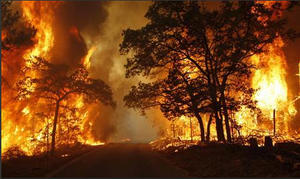DisastersU.S. severe weather insurance losses breach $1.2 billion in March
The estimated economic loss of a series of natural disasters in the United States in March reached approximately $2.0 billion, while insured losses are expected to breach $1.1 billion amid more than 170,000 insurance claims

Events like this Texas wildfire pushed costs over 1 billion dollsrs // Source: ucoz.org
Aon Benfield, the global reinsurance intermediary and capital advisor of Aon plc, the other day released the latest edition of its Global Catastrophe Recap report, which reviews the natural disaster perils that occurred worldwide during March.
The report reveals that a significant severe weather outbreak affected parts of the U.S. Midwest, the Tennessee Valley, and the Southeast during the first week of March, killing at least forty-one people.
The U.S. Storm Prediction Center (SPC) cited at least sixty-five tornado touchdowns, including two EF-4 tornadoes that caused extensive damage in parts of southern Indiana, Kentucky, Tennessee, and southwest Ohio. Total economic losses were estimated at approximately $2.0 billion, while insured losses are expected to breach $1.1 billion amid more than 170,000 insurance claims.
Additional U.S. severe weather activity was recorded during the month, including a system that impacted the Great Lakes. In southeastern Michigan, an EF-3 tornado damaged or destroyed at least 207 homes in the town of Dexter. Total economic losses were estimated at $275 million, while insurers received at least 20,000 claims with payouts expected to exceed $150 million. Late in the month, another storm system resulted in at least forty-six tornado touchdowns across parts of the Plains, Midwest, and the Southeast. Tornadoes were also recorded in Indonesia and Australia.
Steve Jakubowski, president of Impact Forecasting, said: “Following an active 2011 U.S. severe weather season, the first quarter of 2012 has also proven itself to be markedly busy. Through the first three months of 2012, we have already sustained more than $1.8 billion in insured losses from convective storm events as we enter the climatologically most active severe weather months of the year. Despite the heightened activity thus far, it is nearly impossible to forecast and project losses for the rest of 2012.”
Elsewhere during the month, a magnitude-7.4 earthquake rattled central and southern Mexico, killing at least two people. The Mexican Association of Insurance Institutions (AMIS) reported insured losses of around MXN2.07 billion ($163 million), following damage to 44,000 homes, businesses, hospitals and schools.
In other earthquake activity, a magnitude-7.1 temblor struck central Chile, and was labeled an aftershock from February 2010 magnitude-8.8 event. Total economic losses were expected to be below $100 million.
Meanwhile, in China’s Xinjiang region, a magnitude-5.8 earthquake left 36,641 people homeless and caused direct economic losses of CNY523.5 million ($82.7 million).
Flooding affected portions of Australia’s New South Wales (NSW) and Victoria between the end of February and the first half of March, killing at least two people. The Insurance Council of Australia declared a catastrophe for NSW Riverina, NSW Central West, and northern Victoria, as at least 8,914 claims were filed, with insured losses reaching AUD108.2 million ($112.5 million).
Additional flood events during the month were recorded in parts of the Philippines, Fiji, Ecuador, Chile, Colombia, and the United States.
Cyclone Irina’s landfall led to the deaths of at least eighty-four people in Madagascar, Mozambique, and South Africa. More than 78,000 were left homeless and wide swaths of agriculture were submerged.
Also in March, Cyclone Lua made landfall in Western Australia and caused minimal damage. Total economic losses of AUD217 million ($230 million) came from lost business when Port Hedland briefly closed.
